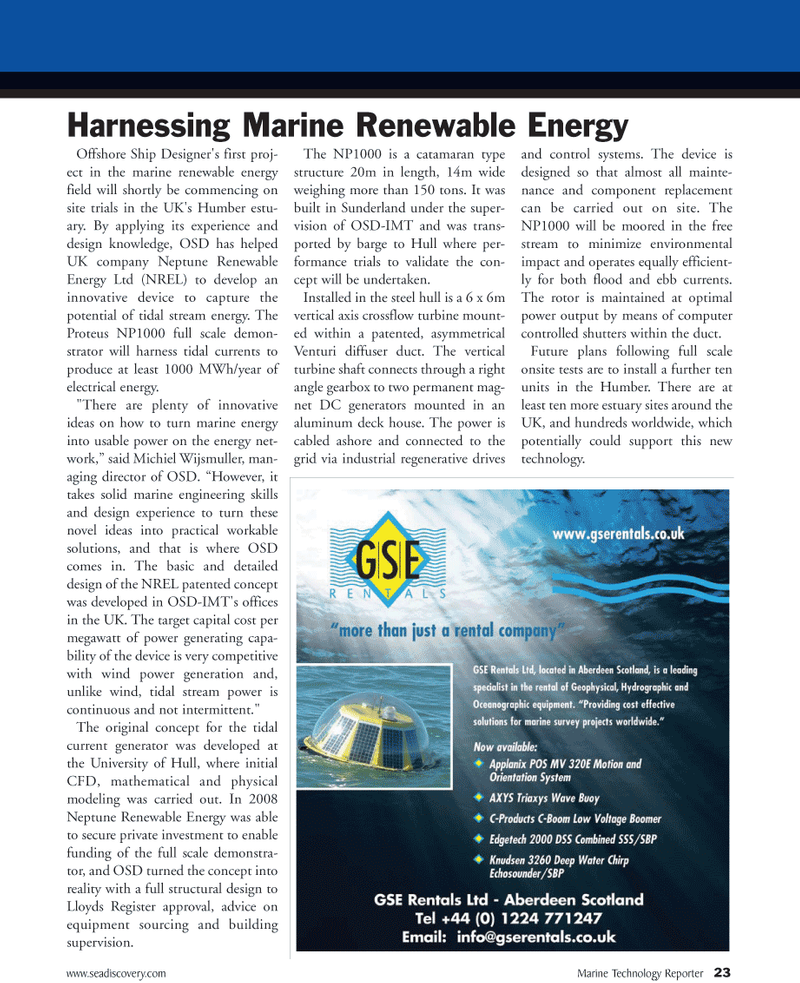
Page 23: of Marine Technology Magazine (October 2010)
Ocean Engineering & Design
Read this page in Pdf, Flash or Html5 edition of October 2010 Marine Technology Magazine
Offshore Ship Designer's first proj- ect in the marine renewable energy field will shortly be commencing on site trials in the UK's Humber estu- ary. By applying its experience and design knowledge, OSD has helped
UK company Neptune Renewable
Energy Ltd (NREL) to develop an innovative device to capture the potential of tidal stream energy. The
Proteus NP1000 full scale demon- strator will harness tidal currents to produce at least 1000 MWh/year of electrical energy. "There are plenty of innovative ideas on how to turn marine energy into usable power on the energy net- work,” said Michiel Wijsmuller, man- aging director of OSD. “However, it takes solid marine engineering skills and design experience to turn these novel ideas into practical workable solutions, and that is where OSD comes in. The basic and detailed design of the NREL patented concept was developed in OSD-IMT's offices in the UK. The target capital cost per megawatt of power generating capa- bility of the device is very competitive with wind power generation and, unlike wind, tidal stream power is continuous and not intermittent."
The original concept for the tidal current generator was developed at the University of Hull, where initial
CFD, mathematical and physical modeling was carried out. In 2008
Neptune Renewable Energy was able to secure private investment to enable funding of the full scale demonstra- tor, and OSD turned the concept into reality with a full structural design to
Lloyds Register approval, advice on equipment sourcing and building supervision.
The NP1000 is a catamaran type structure 20m in length, 14m wide weighing more than 150 tons. It was built in Sunderland under the super- vision of OSD-IMT and was trans- ported by barge to Hull where per- formance trials to validate the con- cept will be undertaken.
Installed in the steel hull is a 6 x 6m vertical axis crossflow turbine mount- ed within a patented, asymmetrical
Venturi diffuser duct. The vertical turbine shaft connects through a right angle gearbox to two permanent mag- net DC generators mounted in an aluminum deck house. The power is cabled ashore and connected to the grid via industrial regenerative drives and control systems. The device is designed so that almost all mainte- nance and component replacement can be carried out on site. The
NP1000 will be moored in the free stream to minimize environmental impact and operates equally efficient- ly for both flood and ebb currents.
The rotor is maintained at optimal power output by means of computer controlled shutters within the duct.
Future plans following full scale onsite tests are to install a further ten units in the Humber. There are at least ten more estuary sites around the
UK, and hundreds worldwide, which potentially could support this new technology. www.seadiscovery.com Marine Technology Reporter 23
Harnessing Marine Renewable Energy

 22
22

 24
24
